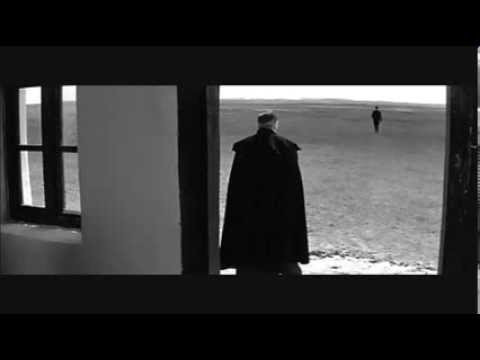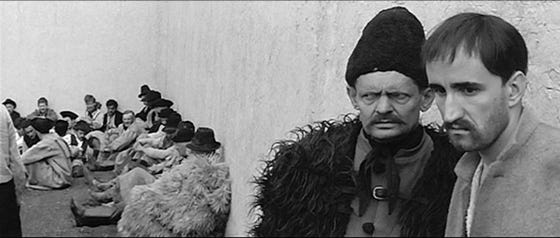Reeling Backward: The Round-Up (1966)
Another dive into the excellent new Miklós Jancsó collection from Kino Lorber brings us to his first international hit, a tense exercise in suspicion and threat.
Once again I’m diving into the excellent new Kino Lorber collection of Hungarian director Miklós Jancsó’s work, this time with his first film to gain major international attention, 1966’s “The Round-Up.”
If you missed the last column on “The Red and White,” perhaps his most well-known film, you can find that here.
Set in 1868, again in the bleak Hungarian step lands, the story concerns the last remaining rebels from the 1848 revolution against Hapsburg rule in Hungary, when the hungry and downtrodden peasants rose up against their bourgeois overlords. The military has been assigned with cruelly rooting out the last of the fighters, most of whom have turned into brigands pillaging the land.
The setting is also inside a prisoner of war camp where farmers and riffraff are mixed in with the rebels. The officers use various forms of guile, torture and trickery to discover the rebels. Their biggest goal is to find the whereabouts of legendary bandit Sándor Rózsa — sort of a Hungarian Robin Hood figure — and suspect he might be mixed in with the general prisoner population.
Compared to “The Red and the White,” “The Round-Up” has a fairly conventional narrative structure (screenplay by Gyula Hernádi) and cinematic style. Jancsó uses long takes and his camera pans and tracks to follow the people as they mill about, though it’s more in your face and personal.
The characterization is similar in that there is no one main character, and we often dally with a figure for a certain time without ever learning their name. The one with the most amount of screen time is Janos Gajdor (János Görbe), a mustachioed villain who is identified as the murderer of a prosperous sheep farmer and his son.
He is used as a spy by the military commander to identify other rebels under the pretense that he will be pardoned if he can find another prisoner who has murdered more people than him. (Janos confesses to three other killings within the last few years, so six or higher is the number set for him.) He roams about the prison, peering at other men for a suitable pick to stand in his stead in the hangman’s gallows.
A prime suspect is Veszelka (Zoltán Latinovits), a stoic fellow who had been one of the prison guards. He is suspected of having killed the real man and taken his place.
Eventually Janos’ activities draw the ire of the other prisoners and he is strangled as a traitor. All this is manipulated by the officers, who deliberately left two cells open to see who would commit the crime. The accused are actually a father and son, Mihaly Kabai Lovas Sr. and Jr.
Eventually they are thrown in with Torma (Gábor Agárdy), an oddly jolly former rebel cavalryman, as was the elder Lovas. They are made to pit themselves against each other in a sort of joust with horses and whips to demonstrate their skill. As the other prisoners are forcibly conscripted into the army, the officer offers Torma, as the victor of the bout, the chance to organize a special cavalry unit.
But it’s yet another ruse, as all those who are picked by Torma as experienced rebel horse riders are rounded up and bags thrown over their heads, their deaths sealed.
As with “The Red and the White,” what stands out about the depiction is the utter lack of value given to life, and the capricious way human bodies are made to march about, put off clothes and put on others, bound or set free. We’re truly made to feel that flesh is just a commodity to be ground up as grist for the wheels of war.
The actors are mostly emotionless, with only Janos showing increasing signs of fear as his situation becomes more desperate. It’s as if they’re resigned to their fate, knowing that any attempt at rebellion is only a fleeting state of independence that will inevitably result in capture, subjugation and death.
Probably the most memorable scene of “The Round-Up” is a huge sort of parade where most of the prisoners are marched onto the field, while a few watch from a high parapet. Two rows of soldiers line up, and an unidentified blonde woman is forced to run naked between them as the men beat her with switches. Each time she reaches the end of the column, she is made to turn around the other way, her torment unending.
It’s never stated what her crime was, or even if there was one. The display is made simply to throw the prisoners into a fever of desperation, with which they comply. Several men on high actually throw themselves to their deaths rather than watch the cruel demonstration. News of the girl’s demise is reported to the officer almost as an afterthought.
The cinematography by Tamás Somló is hauntingly beautiful, widescreen black-and-white images of stark landscapes and a gallery of faces and bodies that parade past the camera. The restoration for the Blu-ray was made from the original 35mm print, and every detail pops off the screen with amazing Neorealist quality.
There’s no way to describe watching “The Round-Up” as an invigorating experience. Despite being just 90 minutes long, it left me physically and emotionally exhausted afterward.
When human lives are treated with such cavalier indifference, it sinks into your soul. And that’s why the weight of “The Round-Up” is still felt so keenly more than a half-century later.





